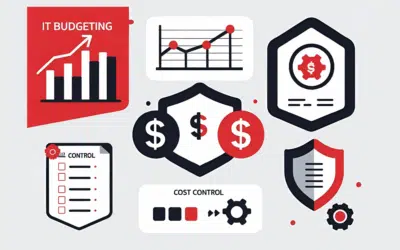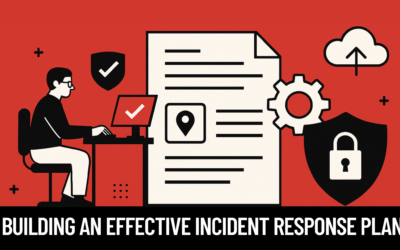One of the biggest challenges faced by owners of retail establishments is how to keep the business safe. This security isn’t just about making sure the front door locks and the alarm system is turned on each night. Cyberattacks are becoming increasingly common, and retail businesses are a prime target. Cybercriminals see retail businesses as easy targets because they often lack the experience, expertise and resources to protect themselves. According to a report by Trustwave, retail businesses accounted for 22% of data breaches in 2019. Many business owners are surprised to learn that the average cost of a data breach for retail businesses is $3.86 million. In many cases, this can lead to the closure of the business, a catastrophic outcome for owners, employees, and customers alike.
Common Cyberthreats Faced by Retail Businesses
The following are some of the most common cyberthreats facing retail businesses:
Phishing
Phishing is a form of social engineering where cybercriminals trick employees into divulging sensitive information by posing as a trustworthy entity, such as a bank or a customer. Emails, phone calls, and text messages can all be used for this purpose.
Phishing attempts can range from relatively unsophisticated emails to highly-targeted and convincing messages that can fool even the most cautious of employees. The goal of phishing is to gain access to private data, such as login credentials or social security numbers.
Often phishing emails try to create a sense of urgency combined with a call-to-action which asks the victim to click a link. For example, an email might say something like:
We regret to inform you that your store’s payment processing has been suspended due to irregularities in your account. To avoid any further inconvenience, we request you to click on the link below to verify your account information.
[Link]
Please note that failure to verify your account within 24 hours will result in the permanent suspension of your payment processing.
Ransomware
The term ransomware refers to malicious software that encrypts business files and demands payment to unlock them. This can cause significant financial and reputational damage to a business, as it may not be able to access critical data or systems until the ransom is paid.
A ransomware attack usually takes place through phishing emails or by exploiting vulnerabilities in a company’s software.
Point-of-sale (POS) attacks
POS attacks involve cybercriminals accessing a business’s payment system to steal credit card information. This can happen through malware that is installed on a business’s payment system or by exploiting vulnerabilities in the system. Once the cybercriminals have access to the payment system, they can collect credit card information and sell it on the dark web.
POS attacks can cause financial losses and customers may lose trust in the business and their ability to protect sensitive information.
Insider threats
In the retail industry, insider threats are a significant cybersecurity risk that arises due to malicious or unintentional actions by employees. These threats include instances where employees intentionally or unintentionally disclose confidential information, misuse their access to sensitive data, and sabotage the organization’s systems. Detecting these threats can be challenging since employees often have authorized access to sensitive data and systems, such as customer information, financial records, and inventory details.
Distributed Denial of Service (DDoS) attacks
A DDoS attack involves flooding a website or network with traffic from multiple sources, preventing legitimate users from accessing it. This can cause significant financial damage to a business, as it may not be able to conduct e-commerce transactions or provide customer support. If retail employees use the site to check stock levels and verify prices, then a DDoS can spill over into a retail location.
Best Practices for Cybersecurity in Retail Businesses
Taking steps to protect themselves from these cyberthreats is important for retail businesses. Here are some best practices to follow:
Cybersecurity Awareness Training for Employees
One of the most important steps a retail business can take is to train its employees on cybersecurity awareness. Employees should be trained to recognize and avoid phishing attempts, to create strong passwords, and to report any suspicious activity. Staying up-to-date on cybersecurity threats and best practices can be achieved through regular training sessions.
Use Secure Payment Systems
Secure payment systems should be used by retail businesses in accordance with industry standards, such as the Payment Card Industry Data Security Standard (PCI DSS). A payment system should be regularly updated with the most recent security patches, and only authorized personnel should have access to the system.
Implement Access Controls
Data and systems should be restricted to authorized personnel only by implementing access controls. This can include using multi-factor authentication, strong passwords, and limiting access to systems and data based on job function. Employees should only have access to the data and systems necessary to perform their job functions.
Regularly Update Software
Keeping software up-to-date with the latest security patches is critical for preventing vulnerabilities. This includes not just payment systems, but all software used by the business. Cybercriminals can exploit security gaps created by outdated software.
Back Up Data
Data should be backed up regularly and stored securely off-site by retail businesses. This can help prevent data loss in the event of a cyber-attack or intrusion.
Conduct Regular Security Assessments
It is important for retailers to conduct regular security assessments to identify potential vulnerabilities and address them before they can be exploited. This can include vulnerability scans, penetration testing, and risk assessments.
Have an Incident Response Plan
Retail businesses should have an incident response plan in place to address cyber-attacks or other security incidents. This plan should include procedures for detecting and containing security incidents, as well as steps for reporting the incident to law enforcement and other stakeholders.
By following these best practices, retail businesses can help mitigate the risks of cyberthreats and protect their customers’ sensitive information. Keeping up with emerging threats requires businesses to continually evaluate and update their cybersecurity measures.
Keep Your Retail Business Safe
In conclusion, cybersecurity is a critical issue for retail businesses. Cyberattacks can cause significant financial and reputational damage. By implementing the best practices we’ve discussed in this blog post, you can protect your retail business from cyberthreats.
At Axxys Technologies, we provide cybersecurity solutions for retail businesses. From network security to helping restore your business after an attack, our team has the experience and expertise necessary to keep your company safe. Contact us now to learn more about how we can help you protect your business from cyberthreats.








